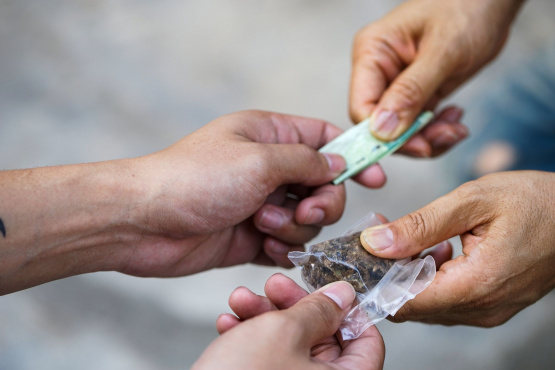3 Reasons the Illicit Marijuana Market Won't Be Marginalized

Investors long cannabis stocks have been making some dangerous connections between the marijuana industry and the market for alcoholic beverages following prohibition. You're about to see that they're hardly even related.
In case you haven't been paying attention, sales of government-sanctioned cannabis throughout Canada have been stagnating at a level too low for big producers like Canopy Growth (NYSE: CGC) and Aurora Cannabis (NYSE: ACB) to scratch out a profit. If you've been wondering how long until licensed producers can capture more than one-fifth of all marijuana sales, the answer is probably never. Here are three reasons why.
Image source: Getty Images.
1. It's cheaper to produce than you think
Countless analysts have confidently predicted how quickly the black market will cease to exist once everyone has access to licensed cannabis. The illicit market for alcohol practically disappeared following the end of prohibition, but that's because big businesses enjoyed economies of scale.
Trying to make your own alcoholic beverages takes a lot of work and the ingredients aren't cheap unless you own a farm. As a result, making your own beer, wine, or spirits usually costs a lot more than purchasing an equally good bottle with a tax stamp on it.
Marijuana is an entirely different animal. With just a few hundred dollars worth of equipment, and an ability to follow instructions, almost anyone can grow more top-quality cannabis than they can possibly consume. Just try to imagine what the market for $20 bottles of Johnnie Walker Red would look like if everyone could produce gallons of 25-year Macallan in their closets for pennies.
This is why it's so hard for the big producers to break even, they're paying employees, licensing technology, and building greenhouses. During the first three months of 2019, Aurora Cannabis lowered the cash cost to produce each gram of cannabis sold down to CA$1.42 during the first three months of 2019, and the company still lost CA$158 million.
Image source: Getty Images.
2. Law enforcement isn't helping
Few governments with a medical or recreational marijuana program outlaw growing your own cannabis and most make it really easy to become a registered caregiver for a limited number of patients. For example, when Michigan adopted a medical marijuana program more than a decade ago, nearly every small-time grower with a clean record became a licensed caregiver.
For years, caregivers were given a chance to sell their excess product to provisioning centers. In theory, all cannabis products must originate from a state-licensed producer, but in practice, provisioning centers stock products that haven't jumped through all the hoops or they don't stay in business very long. The latest workaround involves getting customers to sign a form that states they know the cannabis they're purchasing probably isn't licensed.
Across the EU, and just about anywhere marijuana has been decriminalized for a while you can find compassion clubs that are similar to Michigan's caregivers but with a storefront and hundreds of patients, not five.
The legal status of compassion clubs and caregivers is usually hazy. Generally, they're found in areas where restricting citizens' right to buy the medicine they want is more politically damaging than allowing illegal storefronts to remain open.
Image source: Getty Images.
3. Missing a key demographic
Canada takes 10% of every cannabis sale, then provinces and municipalities add on a tax of their own. For daily users who might not have a whole lot of disposable income to work with, the extra cost quickly becomes prohibitive.
More than 70% of American adults consume alcohol, and an estimated 40% drink excessively. Marijuana isn't nearly as addictive, or capable of livening up a party, and most people simply don't care for it.
Just 6% of Canadians admitted to daily or near-daily cannabis usage in a recent survey, and this group is likely responsible for a majority of total cannabis spending. That's because, unlike alcohol and tobacco, the vast majority of people that try marijuana, even repeatedly, never enjoy it enough to buy it regularly themselves.
When a member of this key demographic does make it into a licensed cannabis store, they're unlikely to find anything useful. Aurora and its peers can make lots of cheap cannabis in their gigantic new greenhouses, but mass-produced cannabis is usually too weak to help people who need to stay medicated all day, every day. Health Canada also has rules that make concentrated oil products weaker than extracts found in the illicit market.
Looking ahead
Even though demand is remaining steady, and international sales aren't going anywhere fast, Canopy Growth is building 5.6 million square feet of cultivation space, which is more than enough to meet 100% of demand for legal cannabis in Canada. Aurora also intends to build enough capacity to meet 100% of Canada's current demand for legal cannabis, and there are at least another 100 producers in Canada battling for the same tiny market.
Overabundance usually leads to lower prices, and Canopy and Aurora aren't anywhere near breaking even yet. That's a recipe for disaster.
More From The Motley Fool
- Beginner's Guide to Investing in Marijuana Stocks
- Marijuana Stocks Are Overhyped: 10 Better Buys for You Now
- Your 2019 Guide to Investing in Marijuana Stocks
Cory Renauer has no position in any of the stocks mentioned. The Motley Fool has no position in any of the stocks mentioned. The Motley Fool has a disclosure policy.